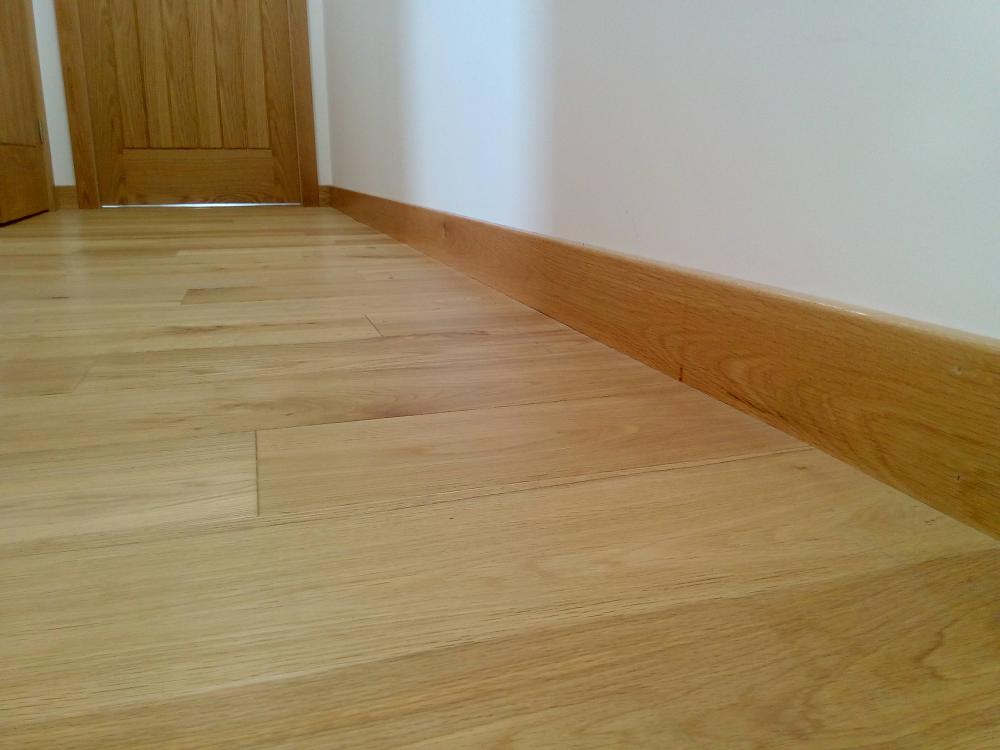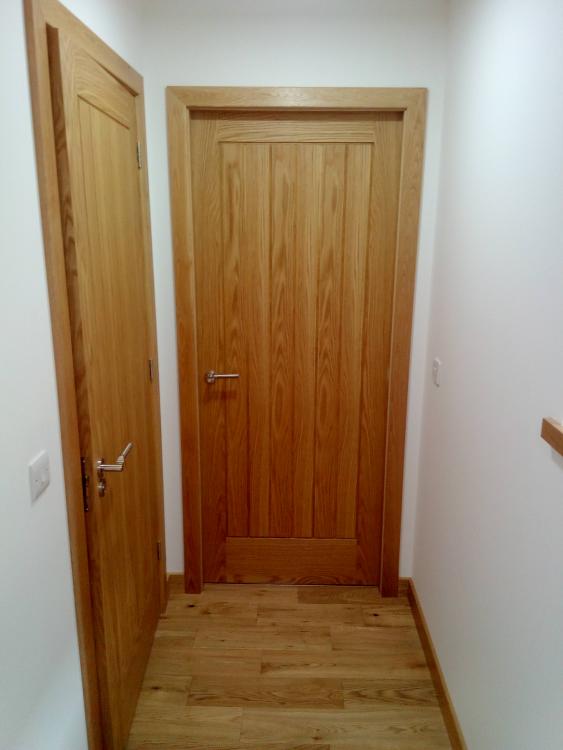Part 16 - Joinery finishes
It's been a couple of months since my last update, during which time we have (almost) finished work and moved in. In this entry I'm going to talk about the joinery work.
As readers may recall, our UFH was switched on 2 weeks before Christmas, which meant there was very little activity on site until the builders came back after their Christmas fortnight.
The joiners were first back, and got to work straight away laying around 105m2 of engineered oak flooring in the main living area, hall, bedrooms and upstairs study. We opted to fully bond the floor to our concrete slab on the ground floor, and went with a simple floated floor in the upstairs study.
We sourced our flooring from:
having gone through a fairly extensive process of obtaining samples from various suppliers and matching the finish to the Osmo Oil used on our skirtings and facings. The flooring has an understated Matt finish and came in random lengths. Having heard reports of random length being code for very short lengths, I was pleasantly surprised to find a good mix of short, medium and long lengths in each pack, each pack having virtually identical contents.
Our flooring adhesive was supplied by the same company - Thomsit (now Ceresit) P618 Parquet flooring adhesive. Like similar products used by other forum members, this is a flexible polymer adhesive that allows the bonded floor to move with the subfloor. The Joiners laying our flooring certainly commented on how easy it was to use compared to Sikaflex, which they had used previously. Coverage worked out at 1m2 per kg. This was a bit less than we hoped for and meant I had to buy a another tub of adhesive locally, at a significant premium to the Thomsit to keep the joiners going.
The adhesive was spread onto the slab with a notched trowel, and the boards pressed down firmly and pushed snuggly to the row of previously laid boards.
Upstairs, we used 18mm flooring and 2mm underlay so the finished floor was level with the top step of our staircase (20mm). The boards were glued together as they were laid on top of the underlay.
The joiners spent just over 4 days laying just under 105m2 of flooring. In general it has turned out very well, and the random lengths provide a more interesting (and in our view more attractive) finish.
Unfortunately, we did find after the floor had been laid, that a few of the boards hadn't bonded to the slab / lifted slightly as the next few rows of flooring were laid. The two areas affected seem to be on the edges of where previously identified dips in the slab were filled with self leveling compound. This really goes to show how critical it is to have a near perfectly level sub floor. Visually of course there was nothing to see, but easily detectable when walking over the floor - a hollow sound and a bit of give like a floating floor as opposed to the rock solid feel of the fully bonded floor. To remedy the problem, the joiners used the approach shown on this film:
In summary, a plunge saw was used to cut the boards out and new boards inserted with sufficient adhesive, then a heavy weight placed on top (in our case buckets of sand) until the adhesive had set.
Fortunately, I did have almost a pack of flooring left, and even more fortunately, the random lengths were all of a standard size so it was easy to select and replace exactly the right size board. Hopefully this fix will stand the test of time.
I have to say I'm still a bit unsure of the underfoot feeling that a bonded floor gives. I'm still finding the experience a little alien, compared to floating floors we have had in the past.
Having laid all the flooring, the joiners moved on to lining the door openings, hanging internal doors, fitting door ironmongery and all the oak facings and skirting boards. In previous houses this phase has never taken that long, as door sets were supplied as part of the timber frame kit, and skirtings / facings were fitted very rapidly. Oak by its nature (IMHO) demands a much greater level of attention to detail when being fitted. Each and every mitre joint on the door facings was sanded silky smooth for a flawless join. Skirting boards were all scribed to the flooring, being hand planed to ensure a tight fit rather than the more common 1mm to 2mm gap you see in some houses. This really does make a difference to the final visual appearance, and although it did take the joiners longer to do this, it just one of those little details that elevates the finish from good to outstanding.
We opted for unfinished rather than pre-finished doors, purely so we could oil them ourselves to match the rest of the oak finishings. Whilst they were £30 a door cheaper, I spent just under an hour per door, sanding and applying 2 coats of oil. Add in the cost of the oil itself and you probably exceed the cost of a pre-finished door. I'm really glad we went down this route as they are a perfect match. Pre-finished doors would have looked fine with a varnished woodwork, but would have looked completely out of place against the oiled oak.
The remaining oak finishes were handrails fixed on top of the studwork balustrades -
and shelving and hanging rails in all of our built in bedroom cupboards / waredrobes.
Oak veneered MDF, oiled to match our other joinery was used in the cupboards, simply to ensure a pleasant finish within.
Overall we're delighted with how the joinery sits against the white walls, and the quality of the finish. It's unfortunate that a few flooring boards did not bond, but my builder, without hesitation, has rectified the problem.
Next entry : Kitchen and Utility
-
 2
2




15 Comments
Recommended Comments
Create an account or sign in to comment
You need to be a member in order to leave a comment
Create an account
Sign up for a new account in our community. It's easy!
Register a new accountSign in
Already have an account? Sign in here.
Sign In Now